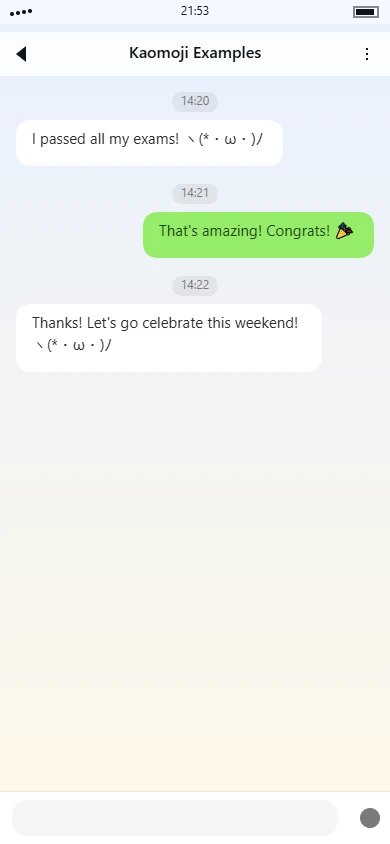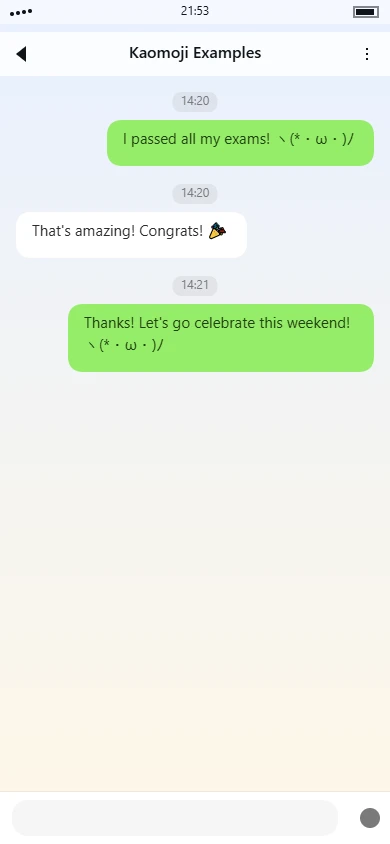(⌒‿⌒) kaomoji Meaning | Usage Tips

Overview
The kaomoji (⌒‿⌒) presents a simple yet expressive facial representation using curved brackets and a unique central character. The overall structure consists of two symmetrical curved brackets serving as closed eyes, with a wavy or curved line in the middle forming the mouth area. This arrangement creates a balanced, harmonious facial expression that conveys a sense of contentment and gentle amusement.
Symbol Breakdown
- Outer parentheses
and(
: These curved brackets frame the face and represent closed eyes. The gentle curvature suggests relaxed, content eyelids rather than tightly squeezed shut eyes.) - Central character
: This character, known as an undertie or a curved line, forms the smiling mouth. Its smooth, continuous curve gives the impression of a genuine, gentle smile without exaggerated corners.‿ - Symmetrical arrangement: The balanced placement of symbols creates a cohesive facial structure where all elements work together to form a unified expression.
- Minimalist approach: The kaomoji achieves its effect with only three main components, demonstrating how simple character combinations can effectively convey emotion.
- Character spacing: The close proximity of elements creates a compact facial representation that reads clearly in text-based communication.
Emotion & Aesthetic Analysis
This kaomoji typically expresses a content, happy emotion with a calm undertone. The closed eyes suggest satisfaction or pleasure, while the gentle curved mouth indicates a sincere smile rather than an exaggerated grin. The overall effect is one of peaceful happiness or quiet amusement.
Compared to similar kaomoji, this version has a more subtle emotional range than those with wide-open eyes or toothy grins. It conveys happiness without being overly enthusiastic, making it suitable for situations where you want to express contentment rather than excitement. The expression falls somewhere between a simple smile and a beaming grin, offering a middle ground in emotional intensity.
The visual style leans toward clean, geometric forms with curved elements that soften the overall appearance. The use of standard keyboard characters makes it accessible across different platforms and devices while maintaining its distinctive look. The kaomoji's balanced proportions and smooth curves create a visually pleasing composition that reads clearly even at small sizes in text messages or online posts.
Tag categories
Use tags to quickly understand this kaomoji.
Usage guide
Usage Guide for (⌒‿⌒)
The (⌒‿⌒) kaomoji is one of the most versatile and widely used emoticons in digital communication, representing a gentle, contented smile with closed eyes that conveys warmth, satisfaction, and peaceful happiness. This emoticon captures the essence of a genuine, heartfelt smile where the eyes naturally close from the intensity of the emotion, creating an impression of sincerity and inner contentment. It's particularly effective in casual online conversations where text alone might fail to communicate the speaker's friendly tone or emotional state. The closed eyes suggest a sense of comfort and trust, making it ideal for situations where you want to express approval, share happy news, or simply maintain a positive atmosphere in the conversation.
What makes (⌒‿⌒) so popular across various platforms is its ability to soften messages that might otherwise sound blunt or neutral. Unlike more exaggerated emoticons that scream excitement or overwhelming joy, this one maintains a calm, composed demeanor while still radiating genuine pleasure. It works well in both one-on-one chats and group conversations, serving as a digital equivalent of a warm, understanding smile that says "I'm happy with how things are going" without being overly enthusiastic. The emoticon finds its home in everything from casual gaming chats to social media comments, often used by people of all ages who appreciate its subtle yet expressive nature.
Common Use Cases
- Responding to good news from a friend with supportive enthusiasm
- Expressing satisfaction after completing a challenging task or project
- Reacting to cute animal photos or heartwarming content on social media
- Showing appreciation for a thoughtful message or kind compliment
- Softening a request to make it sound more polite and friendly
- Celebrating small victories or achievements in gaming communities
- Conveying peaceful contentment during relaxed, casual conversations
- Adding warmth to greetings and farewells in online messaging
- Expressing quiet happiness when sharing personal good news
- Reacting to funny memes or jokes that elicit a genuine, warm smile
- Showing understanding and acceptance in supportive conversations
- Maintaining positive vibes in group chats and community discussions
Example Conversations
-
Friend sharing good news Person A: Just got accepted into my dream university! Person B: That's amazing! So happy for you (⌒‿⌒)
-
Workplace casual chat Colleague: The client loved your presentation design You: Glad to hear that! (⌒‿⌒) I was hoping they'd like the color scheme
-
Gaming community Player 1: Finally beat that impossible boss after 20 tries Player 2: Nice! The persistence paid off (⌒‿⌒)
-
Social media interaction Post: My cat learned to high-five today Comment: That's the cutest thing I've seen all week (⌒‿⌒)
-
Everyday messaging Friend: Thanks for listening to me vent earlier You: Anytime, that's what friends are for (⌒‿⌒)
-
Planning casual meetups Person A: Coffee this Saturday sounds perfect Person B: Looking forward to it! (⌒‿⌒)
Important Notes
-
Avoid using this emoticon in formal business communications, official emails, or serious discussions where professional tone is required. The casual nature of (⌒‿⌒) might undermine your credibility in formal contexts.
-
Be mindful that the meaning can slightly vary across different online communities and platforms. While generally positive, in some contexts it might be interpreted as slightly smug or self-satisfied if used in response to someone else's difficulties.
-
This emoticon works best when you have an established friendly relationship with the recipient. When messaging someone for the first time or in more reserved cultural contexts, consider whether a simple "thank you" or "that's great" might be more appropriate initially.
The (⌒‿⌒) emoticon has become particularly popular in Japanese online communities and has spread globally through anime fandoms and gaming culture. Its balanced expression makes it suitable for various age groups, though younger users might prefer more animated emojis for expressing similar emotions in some platforms.
Usage examples
Real conversation samples that feature this kaomoji.

Example 1

Example 2
Related kaomoji
You might also enjoy these kaomoji.